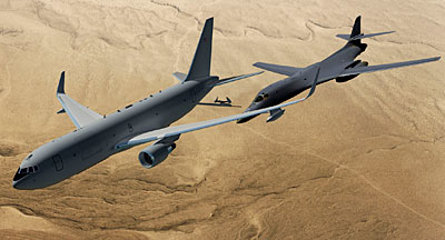Boeing claimed the KC-X contract on 24 February by easily beating the price of EADS North America’s proposal, according to US Air Force officials.
The success of the proposal based on the KC-767 Next Gen Tanker, which is to be renamed the KC-46A, seemed at odds with widespread buzz that the EADS KC-45 had gained an edge over Boeing on price.
“We are ready to build the KC-46A tanker now,” Dennis Muilenburg, chief executive of Boeing’s defence and space business, told reporters after the announcement.
 |
|---|
©BoeingWithin one award after winning the KC-X contract, Boeing released a new concept image showing the newly-awarded KC-46A refuelling a Boeing B-1B bomber. |
Boeing’s actual offer came in lower than its competitor by more than 1%, or at least about $330 million, says Michael Donley, secretary of the air force.
That allowed the air force’s evaluation team to bypass a set of 96 non-mandatory requirements that would only have been triggered if there was less than a 1% differential between the two bids, Donley says.
The air force’s decision was met with “disappointment and concern” by EADS, which previously defeated a Boeing bid for the same contract in 2008. That award was later overturned after Boeing protested the outcome.
The USAF relaunched the competition in September, 2009 with a new acquisition strategy that forced the competitors into a pricing war.
EADS says its review of the air force’s decision “will take some time”. The KC-X bid offered the company an opportunity to establish a new manufacturing base in
Donley urged the losing bidder to respect the air force’s decision and allow the process to move forward.
“We hope that all parties recognise the thorough process and intense, multiple levels of review that have gone into this source selection and will respect this opinion and allow this important procurement to proceed unimpeded,” Donley says.
It is clear that Boeing had several advantages on price by offering the KC-767. The KC-45’s maximum takeoff weight is more than 25% heavier than the KC-767, and extra weight usually implies more cost to build.
Moreover, as a smaller aircraft the KC-767 is expected to burn less fuel in absolute terms. Rep Norm Dicks, a Washington-based Democrat, helped to improve this advantage by successfully pressing the USAF to increase the lifecycle measure for fuel burn from 30 years to 40 years.
“I think that’s an important part of the overall equation,” Muilenburg says.
However, EADS officials had become increasingly confident that the KC-45 would be competitive with Boeing's pricing on the KC-767. Last week, Crosby told reporters that he considered price an "opportunity" for EADS to win in the competition. He also indicated that EADS would protest only if the company discovered a signficant discrepancy between the evaluation criteria and the basis for contract award.
The air force intends to finalise a $3.5 billion contract to complete a system development and demonstration phase, which includes delivering four test aircraft. Boeing is required to deliver the first 18 KC-46As to enter service within six years of contract award. The production phase spans over 13 years for building all 179 aircraft.
Meanwhile, Boeing has confirmed that first flight is scheduled in 2015.
It remains unclear how much risk Boeing has accepted to meet the KC-X contract requirements. The company has never disclosed the exact configuration of the KC-767 New Gen Tanker airframe, nor its refuelling systems.
“We won’t be rolling out any of those” details in the near future, Muilenburg says.
The air force has been seeking to award a contract to replace its aging Boeing KC-135s for most of the last decade.
“I’m pleased at how this produced an outcome … that we will get about delivering a capability that’s long overdue,” Gen Norton Schwartz, chief of staff of the air force, “and we’ll stop talking about it.”
Source: FlightGlobal.com


























